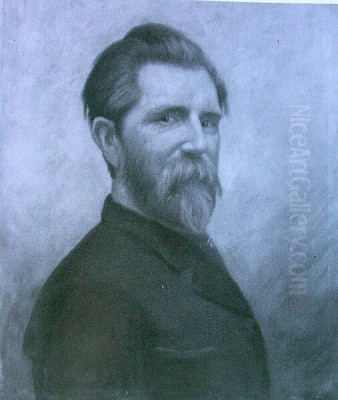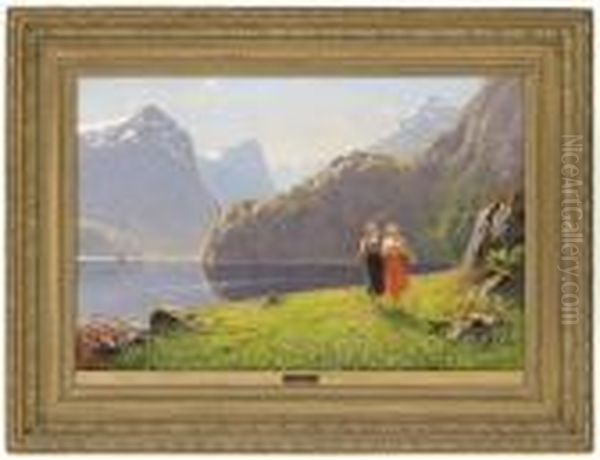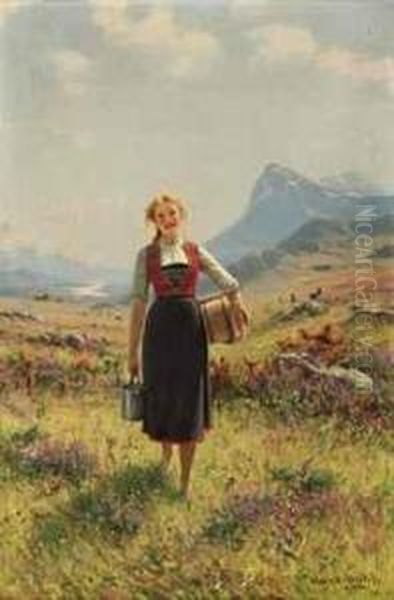
Hans Dahl stands as a prominent figure in Norwegian art history, celebrated for his vibrant and idealized depictions of his homeland's stunning natural beauty, particularly the majestic fjords and the traditional life surrounding them. Active during the late 19th and early 20th centuries, Dahl (1849-1937) became one of Norway's most popular painters, capturing a vision of the nation steeped in sunshine, happiness, and romantic charm. Though sometimes viewed critically by proponents of newer artistic movements, his work resonated deeply with the public both in Norway and abroad, solidifying a picturesque image of the Norwegian landscape that endures to this day.
Early Life and Artistic Inclinations
Born in the village of Granvin, nestled within the Hardanger region of Hordaland, Norway, on February 19, 1849, Hans Dahl displayed an aptitude for art from a young age. His birthplace, surrounded by the dramatic scenery of fjords and mountains, undoubtedly left an indelible mark on his artistic consciousness. However, societal expectations and practical considerations initially led him down a different path. Formal art education was not immediately pursued; instead, Dahl embarked on a military career.
Dahl undertook officer training, initially within the Swedish Army and later serving in the Bergen Brigade of the Norwegian Army. He rose to the rank of lieutenant by 1871. Despite his military commitments, his passion for painting persisted. It was only after serving for several years that he made the decisive move to dedicate his life fully to art, resigning his commission in 1874 to pursue formal training. This transition marked the beginning of a long and prolific career focused on capturing the essence of Norway.
Formal Artistic Training in Norway and Germany
Dahl's formal art education began in Christiania (now Oslo). He sought instruction from established artists, initially studying under Johan Fredrik Eckersberg, a notable landscape painter, and later with Knud Bergslien, known for his historical and genre scenes. These early studies provided him with foundational skills in drawing and painting within the prevailing national romantic traditions of Norway.

Seeking broader horizons and more advanced training, Dahl, like many Scandinavian artists of his generation, looked towards Germany. He first traveled to Karlsruhe, where he enrolled at the Academy of Fine Arts. There, he studied under Hans Gude, a fellow Norwegian and a leading landscape painter associated with the Düsseldorf school, who had become an influential professor. He also received instruction from Wilhelm Riefstahl, further honing his landscape techniques.
His educational journey continued in Düsseldorf, a major centre for academic art training at the time. At the prestigious Kunstakademie Düsseldorf, Dahl studied under influential figures such as Eduard von Gebhardt, known for his historical and religious paintings, and Wilhelm Sohn, a prominent genre and portrait painter. The Düsseldorf school's emphasis on detailed realism, often combined with romantic or sentimental themes, profoundly shaped Dahl's developing style. He absorbed the technical precision and narrative clarity characteristic of the school.
The Emergence of a Signature Style: Fjords, Sunshine, and Folk Life
Following his extensive training in Germany, Hans Dahl developed a distinct and highly recognizable artistic style. He chose the landscapes of western Norway, particularly the dramatic fjord regions, as his primary subject matter. Unlike some of his contemporaries who explored darker, more melancholic aspects of nature, Dahl focused almost exclusively on the bright, cheerful, and idyllic side of Norwegian life and scenery.
His paintings are characterized by their luminous quality, often depicting sunny summer days. He masterfully captured the play of light on water, the reflections shimmering on the fjord surfaces, and the clear, crisp atmosphere of the Norwegian summer. Bright, saturated colours dominate his palette, contributing to the overall feeling of optimism and vitality that permeates his work. Dahl frequently populated his landscapes with figures, adding a narrative and human element.
A recurring motif in Dahl's oeuvre is the depiction of young Norwegian women, often dressed in traditional folk costumes, known as bunad. These figures are typically shown smiling, engaged in leisurely activities like rowing boats, gathering flowers, or simply enjoying the beauty of their surroundings. These portrayals contributed significantly to the national romantic sentiment prevalent at the time, celebrating traditional Norwegian culture and the perceived innocence and beauty of rural life. His detailed rendering, influenced by his Düsseldorf training, extended to the costumes, boats, and surrounding natural elements.
Balestrand: An Enduring Muse

A significant portion of Hans Dahl's most famous works is intimately connected with the village of Balestrand, located on the shores of the Sognefjord, Norway's longest and deepest fjord. Dahl first visited Balestrand in 1888 and was immediately captivated by its breathtaking scenery. He subsequently built a summer home there, Villa Strandheim, designed in the distinctive Dragestil (Dragon Style) inspired by Viking and medieval Norwegian architecture.
From 1893 until his death, Dahl spent his summers in Balestrand, using the dramatic landscapes and local life as constant inspiration. The towering mountains plunging into the serene fjord waters, the changing light, and the local people became central elements in his paintings. Villa Strandheim itself became a local landmark and a hub for the artist during his productive summer months. His presence also contributed to Balestrand's reputation as an artists' colony.
His deep connection to this specific location allowed him to develop an intimate understanding of its unique atmosphere and visual characteristics. Many of his paintings can be identified as depicting specific views around Balestrand, capturing the essence of this particular corner of the Sognefjord with affection and remarkable consistency in style over several decades.
Key Themes and Recurring Motifs
Hans Dahl's body of work revolves around a consistent set of themes and motifs that define his artistic identity. The Norwegian fjord landscape is paramount, presented not just as a geographical location but as a symbol of national pride and natural grandeur. He emphasized the sublime beauty of the mountains, the vastness of the water, and the unique interplay of land, sea, and sky.
Sunlight is almost a tangible presence in his paintings. He rarely depicted stormy or overcast weather, preferring the brilliance of summer days. This focus on sunshine creates an atmosphere of warmth, joy, and idyllic perfection. The reflections on the water are rendered with particular skill, adding depth and luminosity to his compositions.
The human element, particularly young, happy figures in traditional dress, is another defining characteristic. These figures are not merely incidental additions but central to the narrative, embodying a romanticized vision of Norwegian folk life. They represent health, innocence, and a harmonious connection with nature. Boats, often the traditional wooden rowing boats of the fjords, feature prominently, serving both as compositional elements and symbols of the local way of life.
Notable Works and Artistic Output
Hans Dahl was an incredibly prolific painter, producing a vast number of works throughout his long career. While specific titles can sometimes be generic or repeated, certain compositions stand out as representative of his style and subject matter. Among his most celebrated and characteristic works are paintings often titled along the lines of:
"Summerday by Balestrand" (or similar variations): These works epitomize his focus on the Sognefjord location, typically featuring bright sunshine, sparkling water, distant mountains, and often figures in a boat or near the shore.
"On the Quiet Lake" ("Am stille Seen"): This title, sometimes appearing in German due to his connections there, points to serene depictions of fjord or lake scenes, emphasizing tranquility and reflection.
"Fjord Landscape with Figures": A common descriptive title for many works showing the interaction between people (often in bunad) and the grand fjord environment.
"Young Woman in a Boat on the Fjord": A recurring theme highlighting youthful beauty and leisure within the majestic natural setting.
His technique remained remarkably consistent: detailed brushwork, a bright, high-key palette, and compositions designed for maximum picturesque effect. While he primarily worked in oil on canvas, the sheer volume of his output suggests a dedicated and efficient working method, likely involving preparatory sketches and potentially studio repetitions of popular themes.
Career Success and International Recognition
Despite later critical reservations from modernist circles, Hans Dahl enjoyed considerable success and popularity during his lifetime. His paintings found a ready market both within Norway and internationally, particularly in Germany and Great Britain. His idealized, easily accessible depictions of Norway appealed to a broad audience, including tourists seeking souvenirs and collectors drawn to romantic landscapes.
He exhibited regularly in major European cities, including Berlin, Munich, Düsseldorf, Vienna, and Paris, gaining exposure and building his reputation. His work garnered significant attention from prominent figures. Notably, German Emperor Kaiser Wilhelm II was a great admirer and patron of Dahl's art. The Kaiser visited Dahl in Balestrand on several occasions during his annual summer cruises to Norway and purchased numerous paintings.
In recognition of his artistic achievements and popularity, Kaiser Wilhelm II conferred upon him the title of Professor in 1910. Dahl also received official recognition from his home country; in 1902, he was appointed a Knight, First Class, of the Royal Norwegian Order of St. Olav for his contributions to art. This blend of popular appeal and official accolades cemented his status as a leading Norwegian painter of his era.
Artistic Context: Romanticism vs. Realism and Naturalism
Hans Dahl's career unfolded during a period of significant transition in European and Norwegian art. While he remained steadfastly committed to the ideals of late Romanticism and the detailed techniques of the Düsseldorf School, younger generations of artists in Norway were embracing new movements like Realism and Naturalism.
Artists associated with the "Lysaker Circle," such as Erik Werenskiold, Gerhard Munthe, and Eilif Peterssen, along with prominent figures like Christian Krohg and Frits Thaulow, sought a more truthful, less idealized representation of Norwegian life and landscape. They often focused on everyday hardships, social issues, and the more rugged, unadorned aspects of nature, employing looser brushwork and often more subdued palettes influenced by French Impressionism and Naturalism.
This divergence led to criticism of Dahl's work by some influential art critics and fellow artists in Norway, including Christian Krohg and Jens Thiis (later director of the National Gallery in Oslo). They viewed his style as conservative, overly sentimental, repetitive, and out of step with modern artistic developments. They argued that his perpetually sunny and cheerful depictions offered a superficial "tourist" view of Norway, lacking depth and authenticity. Dahl, however, largely ignored these criticisms and continued to paint in the style that brought him success and resonated with his audience.
Life Between Balestrand and Berlin
Reflecting his strong ties to both Norway and Germany, Hans Dahl maintained a lifestyle that balanced his time between the two countries for many years. He typically spent the summer months at his beloved Villa Strandheim in Balestrand, immersing himself in the Norwegian landscape that was the core subject of his art. This period was likely his most intensive for gathering inspiration and possibly creating plein-air sketches.
During the winter months, Dahl and his family resided primarily in Germany, often in Berlin-Wilmersdorf. This allowed him to maintain connections with the German art market, patrons, and exhibition venues where his work was highly popular. His wife, Clemence Annie Sophie Hedwig Neumann (1862–1928), was German, further strengthening these ties. They had a son, Hans Andreas Dahl (1881–1919), who also became a painter, often working in a style very similar to his father's, which can sometimes lead to confusion in attributions.
This dual residency highlights the international dimension of Dahl's career and the importance of the German art scene for Scandinavian artists of his generation. It also underscores his position as an artist whose appeal transcended national borders, even while his subject matter remained intensely focused on his Norwegian homeland.
Later Years and Enduring Legacy
Hans Dahl continued to paint actively into his later years, remaining faithful to the style and subjects that had defined his career. He passed away in Balestrand on July 27, 1937, at the age of 88, having spent his final summer in the place that had inspired him for over four decades.
Despite the criticisms levelled against him by modernist critics, Hans Dahl's legacy is significant. He played a crucial role in popularizing the image of the Norwegian fjords as idyllic, sun-drenched landscapes, an image that strongly influenced tourism and the perception of Norway abroad. His works remain highly sought after by collectors, and reproductions of his paintings continue to be popular.
While art history often prioritizes innovation and stylistic evolution, Dahl's work represents the enduring appeal of romantic landscape painting and technical proficiency. He stands alongside artists like Adelsteen Normann, another Norwegian painter known for dramatic fjord scenes popular internationally, as a key figure in the late Romantic tradition in Norway. Though perhaps not an innovator in the modernist sense, Hans Dahl was a master craftsman who captured a specific, highly appealing vision of his country's natural beauty, securing his place as an important and widely recognized Norwegian artist. His paintings serve as vibrant documents of a romanticized, yet deeply cherished, view of Norway's magnificent scenery.